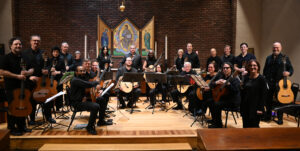by J. Scott Matejicka
March 2006
Unlike a beginning violinist or wind player who tunes as he plays, the beginning guitarist has a tendency to believe that time spent tuning his instrument is wasted; that these are minutes he could have spent working instead on technical challenges. He so rarely tunes his guitar that tuning becomes an immensely time-consuming and daunting task. However, just like the importance one might place on running one passage over and over again, tuning should be practiced. Gone are the days of more complicated systems of tuning such as Pythagorean, mean-tone, and just-intonation, as well as the old temperamental gut strings and friction pegs. The classical guitar of today is a modern wonder, with machine heads and synthetic strings all tuned in equal temperament. But despite these technological advantages, it is often said that guitarists spend half of their time tuning the guitar and the other half playing on a guitar that is out of tune!
Let us tune
When I first began studying the guitar, I was taught to tune pairs of adjacent strings, to begin with the sixth string and work my way to the first. The problem with this approach is the looming possibility of cumulative error. If any one of the beginning strings is slightly out of tune, the subsequent strings never have a chance. For students new to music, the best way to begin is by using a tuner. If you identify a string as being sharp, make the string flat and approach the in-tune pitch from below. The friction created in the groove of the nut helps to sustain the accuracy of the pitch. As you become more comfortable with matching pitch, you can begin to use a tuning fork. By matching the pitch of your fifth string (fifth fret harmonic) to an A440 tuning fork, you can use this string as your reference pitch to tune all but one string. The most audibly accessible interval for tuning is the unison. The harmonics found on frets V, VII & XII of the bass strings will provide clear reference pitches so that all six strings harmonically agree. The following is a chart of unison harmonics to compare:
5th string 7th fret & 6th string 5th fret
5th string 5th fret & 4th string 7th fret
4th string 5th fret & 3rd string 7th fret
(double check with 5th string 12th fret & the A on second fret 3rd string)
6th string 7th fret & the open 2nd string
(double check with 4th string 12th fret & the A on the third fret 2nd string)
5th string 7th fret & the open 1st string
When tuning the third and second strings, a compromise is necessary. If the open third string is tuned very precisely to a G, the fretted A on the second fret will be slightly sharp. So, double-checking the fretted A with the twelfth fret harmonic of the fifth string will clarify the discrepancy. The same also holds true when tuning the open second string. Unless you are playing a piece with a tonal center of B or D, the open B and fretted D relationship should be a compromise. The B will ultimately be slightly flat and the D slightly sharp.
Once you have mastered a general tuning system, you can begin to tune your guitar according to the key of the piece you are playing. Specifically, the root of the tonic (I or i) chord is the highest priority when fine-tuning your guitar. For instance, when playing a piece of music in the key of A Major or minor, the A’s of the open fifth string, the second fret of the third string, and the fifth fret of the first string should all agree. The same should be done for the root of the dominant (V) chord. Since you are dealing with an equally tempered tuning system, the only truly “perfect” intervals are the unison and the octave. Unfortunately, as you move higher on the neck, you may find your guitar possesses intonation problems. Therefore, your next priority is to identify “problem pitches.” If you know the A on the tenth fret of the second string is going to make you cringe when you get to it in measure 16, plan ahead and make it part of your fine-tuning process.
Common Alternate Tunings
At some point in your exploration of guitar literature, you will inevitably come across some alternate guitar tunings. The most common is the “drop D” tuning. The sixth string is tuned a D, extending the range of the guitar by a whole step. As one might imagine, this alteration is mainly reserved for pieces with a tonal center of D. A surefire way to achieve a well-tuned low D is to play the twelfth fret harmonic of the sixth string and match it to the open fourth string. Since the threading of machine heads vary, you must get to know your tuning pegs. Figure out how many turns of the tuning peg it takes to move your sixth string from E to D and practice it. A slight tug on the string will also expedite the settling of the pitch.
The repertoire of the modern guitarist reaches back to the early 16th century. Compositions by such composers as Luys de Milan (vihuela), Adrian Le Roy (guitar, lute, and theorbo) and John Dowland (lute) are often performed at guitar recitals. The tuning of the vihuela and the lute can be achieved by lowering the third string of the modern guitar to an F#. Back when these pieces were written, a universal tuning system had not yet been established. The tuning of the vihuela and the lute is now approximated at around a minor third higher than that of the modern guitar. Consequently, some performers prefer to use a capo on the second or third fret. Since both the vihuela and the lute have a shorter scale length than our instrument, using a capo does away with those “impossible to reach” notes.
Performance Practice
The guitar is an extremely temperamental instrument. When preparing for a performance, you are often faced with temperature adjustment from green room to stage. Although it is a difficult situation to predict, there are ways you can prepare for the unpredictable. Once out on stage, quietly go through your tuning procedure. If you are faced with not being able to identify whether a questionable string is sharp or flat, make the string noticeably flat in order to approach the true pitch from a clear point of reference. Always take the time to make sure your instrument is in tune (surely better than, in hindsight, wishing you had). Stopping once you have begun a piece should be saved as a last resort. During a multiple movement piece, time should be taken to make adjustments to tuning ONLY if necessary. Every performer should be actively listening to his intonation. If you hear a problem arise during a piece, a little extra vibrato may suit as a temporary solution. You may also come across a moment in the piece where your left hand is not under obligation to fret notes and is free to make a quick adjustment. Just make sure you know EXACTLY which string is causing the problem and just how much adjustment is needed. In the case of alternate tunings, the best idea is to plan ahead. If you know your “drop D” is inevitably going to go sharp, you might want to strategically choreograph a tuning adjustment in the piece. The best strategy is to have an orderly system of tuning memorized. Practice it as often as you would a piece of music. The act of tuning should never take a back seat to the challenges of technical issues. No matter how virtuosic your playing is, no one wants to hear you play brilliantly out of tune! The concept of playing in-tune should drive every musical journey on which you embark. So take your time and be patient; the more you practice your tuning, the more you will develop your ear. And of course, the more you develop your ear, the more you will PLAY IN TUNE!









